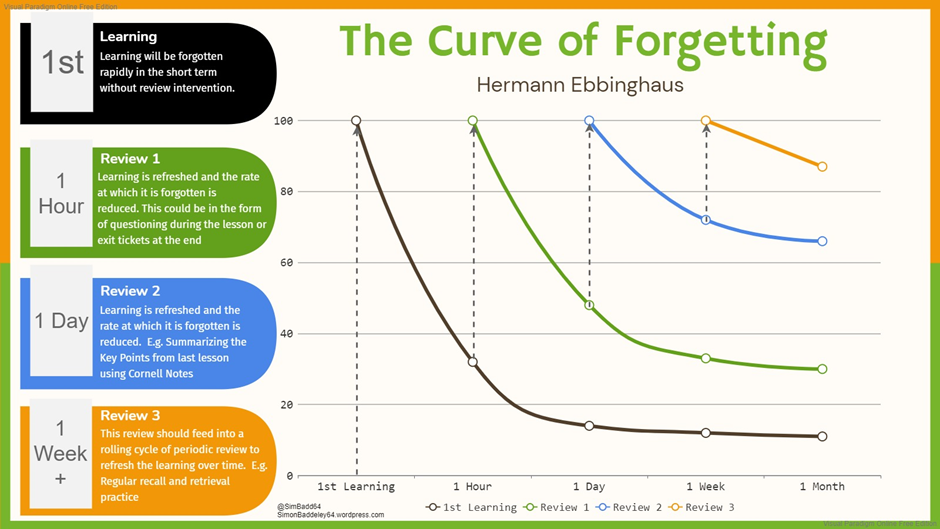How to Revise - The 5 Key Revision Strategies
Please find our Effective Revision Guide here.
Revision is a key element of preparing for assessments. No matter how good we think our memory is, the reality is that you need to re-visit material regularly to make sure that it sticks in our long-term memory.

The image above shows how quickly information can be lost if it isn’t reviewed. Within one month, 90% of new knowledge can be lost. Revision is a key step to help you remember as it refreshes the learning, prevents misconceptions and even slows the rate at which the information is lost.
At Fullhurst Community College we promote five key revision strategies:
Strategy 1 - Look-cover-write-check:
This revision method works really well with the Knowledge Organisers, but exercise book or textbooks can also be used. See below for instructions on how to use this method effectively.

Look – read (aloud) a small section of information from the Knowledge Organiser thoroughly.
Cover – cover over the information you have read.
Write – completely from memory, aim to write down everything that you read aloud from the Knowledge Organiser.
Check – compare what you have written with what is in the Knowledge Organiser.
Use a different coloured pen to add in anything you missed, or got incorrect. This is the most important stage, so don’t skip it! Repeat this process at least three times for each section of information, then move to the next. Keep returning to information you have already practised to check if it is still in your memory.
Strategy 2 – Flashcards:
Flashcards are most helpful when you make them yourself, using your Knowledge Organiser, your classbook, or a textbook.
If you would like some more flashcards, please speak to us at school and we can get them for you.
Here’s how to use them:
1. Make your set of flashcards by putting a question on one side of the flashcard, and the answer on the other.
2. Once you have made your flashcards, work through them in turn. For each card, read the question on it, or get someone else to read it to you.
3. Say the answer aloud, or write it down.
4. Check your answer against the answer on the flashcard.
5. If you get the answer correct, put it in one pile. If you don’t get the answer correct, it’s ok, but put it in a second pile.
6. Once you have worked through your set of flashcards, go through the pile of flashcards that you didn’t get right again – see if you can remember the answer this time.
Strategy 3 – Mind mapping / Concept Maps:
For this, you can either use a blank sheet of paper, or a concept map. If you ask us at school, we can get you more concept maps.
Here’s how to do it:
1. Select a topic you would like to revise.
2. If you are using a concept map, divide the topic into four different areas.
3. Write down as much as you can about your topic, completely from memory.
4. You could use colours, or images to help with your memory – or you could draw lines to make links between different key areas.
5. Once you are sure you have written down everything you can remember, use your Knowledge Organiser and/or your exercise book to check you have remembered everything.
6. Use a different coloured pen to add in anything you have forgotten, or not got quite right.

Strategy 4 – Self quizzing:
For this method, all you need is a set of questions, or a gap fill. You could make this yourself, or get it from your teacher. The science faculty Knowledge Organisers have self-quizzing questions included!
1. Using the questions or the gap fill, complete as many answers as you can completely from memory.
2. Check your answers, using your Knowledge Organiser, or your classbook, or ask for a set of answers to check against. Fill in any gaps with a different colour pen.
3. Repeat until you have got them all correct on multiple occasions.
Strategy 5 - Concrete examples and practice tasks:
Once exams start to get closer, it is important that you start to practise the skills they will need for their subjects, as well as ensuring they have remembered the knowledge they have been taught.
These revision methods help with this. A concrete example is an example answer to a question (sometimes called a ‘model answer’) – you will be given these in class as part of your lessons, but these will also be in revision booklets when preparing for your GCSE exams.
Students should use the concrete example to see:
1. How it approached the exam task.
2. What things it included that made it good (showing working out, including key words, etc).
A practice task (or past exam question) is an example type of task that students might get in an exam. These will be looked at in class, and will be in revision booklets when preparing for your GCSE exams – but students can ask their teachers if they want more of these.
Remember to make sure the concrete examples and practice tasks you use are relevant to your exam board and specification. If in doubt, check with your teacher!
